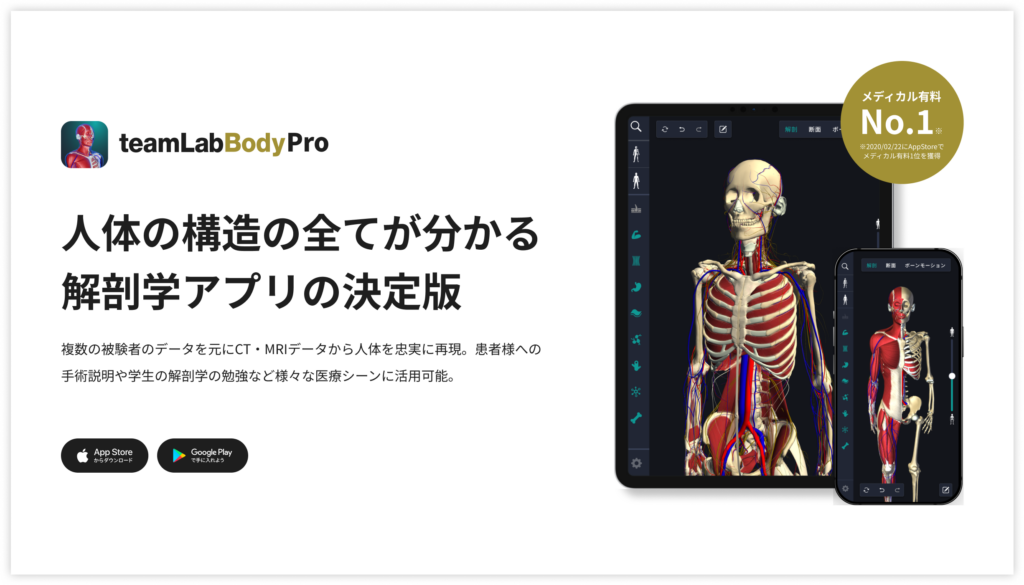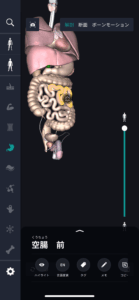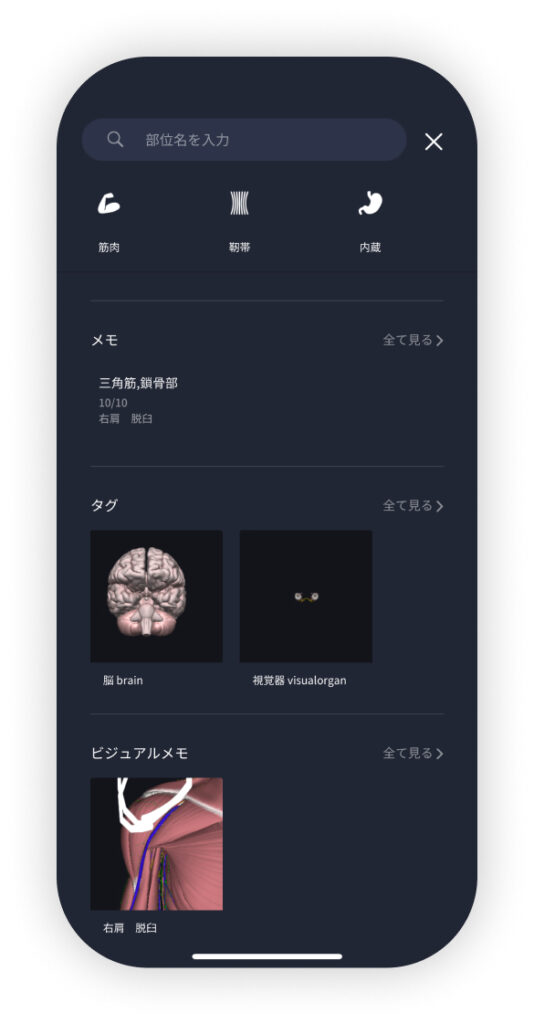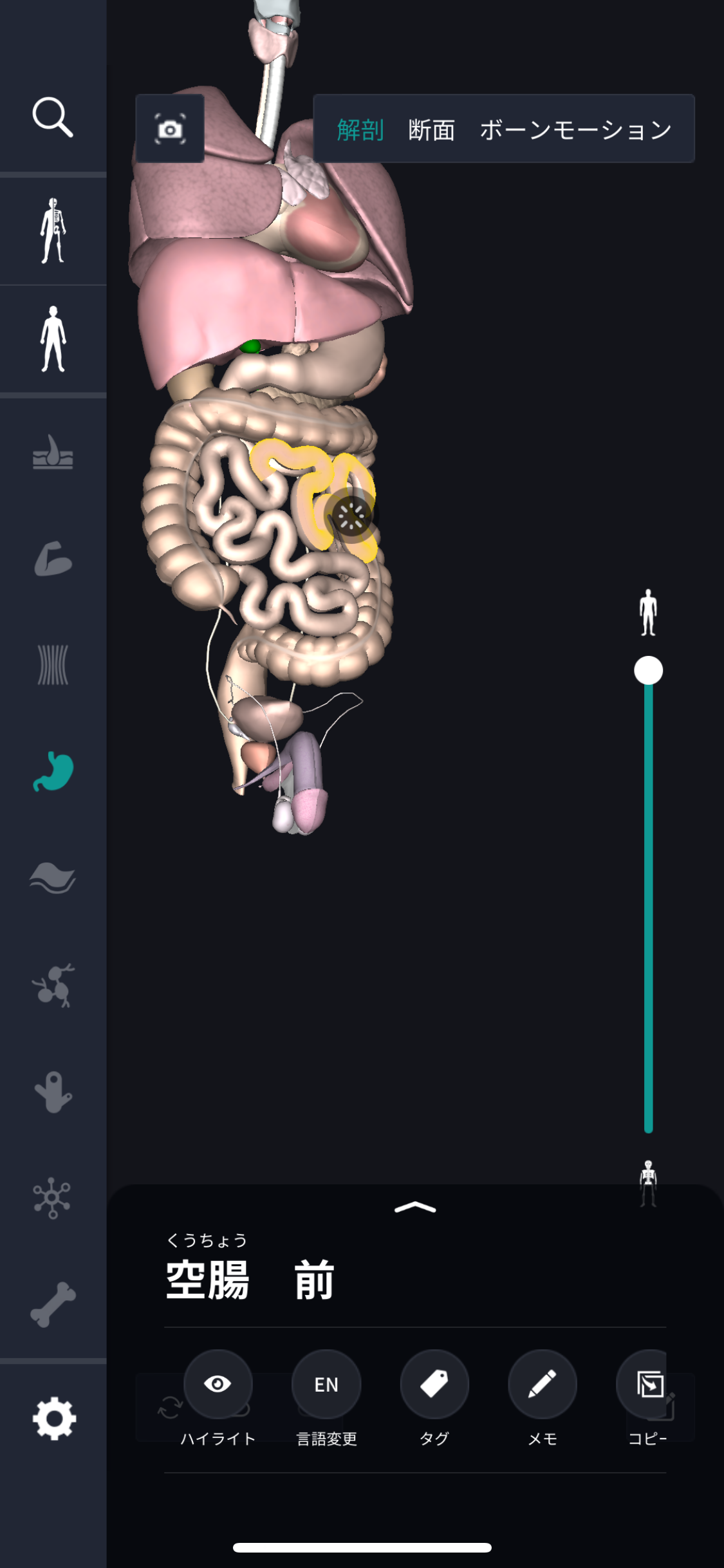beginning
In this article, I will explain effective study methods, starting with knowledge of specialized parts in human anatomy.
In human anatomy, it is necessary not only to memorize the names of various organs, muscles, and bones, but also to remember where they are located in the body. Therefore, it is necessary to learn as efficiently as possible.
I hope you can read this article and use the app to deepen your understanding even a little bit.
Now, I will explain the contents of the “jejunum” and how to study human anatomy.
teamLab Body Pro Free Download
A 3D anatomy app that shows all the structures of the human body
Download teamLab Body Pro here!

What is the jejunum?
In the anatomy application, you can view a selection of anatomy 3D models. In this model, there are various observation methods such as surfaces, cross-sections, and nervous systems. This time, I'll explain using an anatomy application.
About jejunum

The jejunum is part of the human digestive organ, and refers to a part of the small intestine, which is an elongated tubular organ. After food is digested in the stomach, food passes through the jejunum through a downstream digestive process. The jejunum is one of the places in the digestive tract where nutrient absorption is most active. Nutrients from digested food pass through the walls of the jejunum, are absorbed into the blood and sent to various parts of the body. The jejunum plays an important role in making the most of nutrients and contributes to maintaining health and energy. The name of this part comes from the Latin word “jejunus,” which means “empty” and “without food.” This is due to the fact that when the intestines were anatomically investigated, the jejunum was often normally empty. The jejunum is located in the middle of the small intestine and is approximately 2.5 meters long. This part plays an important role by using digestive enzymes, etc., to further break down food and change it into a form that the body can use as energy. The health of the jejunum is directly linked to overall health, so it is important to keep a well-balanced diet in mind. Paying attention to food choices and eating methods, and getting enough nutrition is key to maintaining the health of the entire digestive system, starting with the jejunum.
Study points
The location and structure of the jejunum
The jejunum is located in the central part of the small intestine, and the small intestine can be broadly divided into three parts. The first about 25 cm is the duodenum, then about 2.5 m is the jejunum, and the remaining part is the ileum. Therefore, the upper part close to the stomach is the duodenum, the middle is the jejunum, and the end is the ileum. The jejunum is the part where food enters the duodenum from the stomach and continues after it is partially digested, and is the main place for nutrient absorption. For this reason, the jejunum is covered by many small projections called villi, which expand the surface area. This allows nutrients to be absorbed efficiently from food. Microvilli, which are even finer projections, exist on the inner wall of the jejunum to maximize nutrient absorption. Due to this structure, the jejunum efficiently absorbs various nutrients such as carbohydrates, proteins, lipids, vitamins, and minerals from food, and plays an important role in sending these to the bloodstream. This special soft hair structure in the jejunum is very important during digestion and nutrient absorption processes. Therefore, the health of the jejunum greatly affects overall digestive transfer efficiency.
The role and function of the jejunum
The jejunum is a part of the small intestine that mainly specializes in the absorption of nutrients. After food is partially digested in the stomach, nutrients that are further digested in this jejunum and broken down into a form the body can use are absorbed. The jejunum plays a very important role in this process. In order to increase absorption efficiency, the inner wall of the jejunum is covered with numerous projections called villi, which greatly increase the surface area. Therefore, not only the main nutrients such as carbohydrates, proteins, and lipids, but also vitamins and minerals are effectively absorbed and carried to the blood. Also, in the jejunum, enzymes are secreted to break down digested food even smaller. As these enzymes work, substances in food are broken down into forms that are easily absorbed by the body. Furthermore, the jejunum is involved in water absorption. Proper water absorption maintains water balance in the body and is critical to maintaining overall health. Thus, the jejunum plays a central role in efficiently ingesting nutrients needed by the body. In order to maintain the function of the jejunum and protect health, lifestyle habits such as living a healthy diet, proper exercise, and adequate hydration are important.
English notation for jejunum
I will explain the English notation for jejunum. The jejunum is called “jejunum” (jujunum) in English. The name comes from Latin and is based on the word “jejunus.” “Jejunus” means “empty” in Latin. The reason it was given this name is because when ancient anatomists observed corpses, the jejunum was more often empty than other digestive organs. The jejunum is part of the small intestine and is located between the duodenum and ileum. Therefore, when identifying this part in medical literature and anatomy books, the accurate English notation “jejunum” is used. This name is particularly important in specialized fields such as medicine and biology. In academic communication, using accurate part names is essential for improving the accuracy of information transmission. Therefore, when referring to the jejunum, it has become established that it is expressed as “jejunum” in English. By knowing the background and origin of this word, you will deepen your understanding in specialized sentences and dialogues.
How to study human anatomy
I will explain specific study methods using human anatomy applications.
Check your past learning history and practice repeatedly
Here are the steps to check your anatomy learning history and practice iteratively effectively.
1. Check your learning history in the app
Reviewing your learning history with the application is an important step in effectively advancing anatomy learning. First, launch the app and go to the learning history section from the main menu. Many anatomy apps are designed to show your progress in the form of graphs and lists, so you can visually check which parts you've learned about and how much time you've spent.
By using this data, you can understand which areas you have strengths in and where you need to spend more time and effort. We also recommend using a dedicated tag or notebook function to mark areas you are particularly weak at or where you need to relearn. Regularly checking your learning history and looking back on past learning content will lead to efficient review and deepening understanding.
2.Make a plan for iterative learning
Making an efficient repetitive learning plan based on learning history is extremely effective in promoting knowledge retention. First, identify weak points and areas where you need to relearn. Next, arrange these study items into a weekly or monthly calendar and create a specific study schedule. By proceeding in a planned manner, you can learn each part evenly and avoid packing in a large amount of information at once.
Using a task management app or digital calendar to set study reminders is effective. Also, it's important to have the flexibility to regularly review progress and revise plans as needed. By having goals and proceeding with your studies in a planned manner, you can efficiently acquire anatomical knowledge.
3.Use 3D features to learn visually
By utilizing the 3D function, learning anatomy is easier to understand visually. The 3D model shows the structure of the human body three-dimensionally, and each part can be observed in detail. This makes it possible to intuitively grasp positional relationships between deep muscles and organs that are difficult to capture in a planar view. For example, you can learn even the smallest details by rotating specific muscles and bones and zooming in and out.
Also, there are many apps that have the function of displaying cross-sectional views of each part using a 3D model, which is useful for deepening understanding of internal structures. This diversity of visual information helps with memory retention and improves immediate responsiveness in tests and practice situations. By utilizing the 3D function and learning visually, you can learn anatomy knowledge more deeply and efficiently.
Use the memo function concretely

Make notes so you don't forget the things and points you've noticed while studying. The memo function can be used for different purposes, such as inputting text, saving images, and writing memos. Tag your notes to make them easier to review later.
Test your learning regularly in the form of quizzes
Regularly testing what you've learned in a quiz format is a very effective way to anchor your anatomy knowledge. Quiz-style tests help you objectively grasp your level of understanding and areas you lack while repeating knowledge.
For example, by using a learning app to conduct quizzes every specific period, you can reconfirm what you've learned and strengthen your memory. There are a wide range of quiz formats, such as multiple choice questions, fill-in-the-blank questions, and short answer questions, and each helps understanding from a different angle and develops the ability to utilize various types of knowledge.
Get feedback
If possible, get feedback from other learners and experts. It helps you find your own gaps in understanding and areas for improvement. You can also keep yourself motivated to learn by regularly testing yourself. Feeling a sense of accomplishment and progress increases motivation for continuous learning.
summary
This time, I explained how to study about the “jejunum” using an application!
Thank you for reading this far.
I would be happy if reading this article helped you learn about anatomy.
Learning is a long, never-ending journey, but I sincerely wish you all the best. Let's continue to study together and work hard for the national exam!
Please look forward to the next blog.




